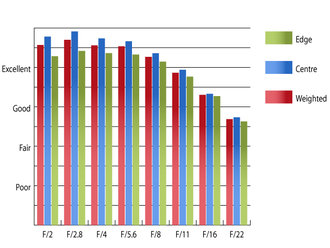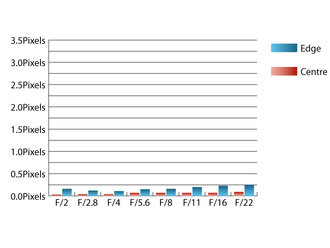Canon EF 200mm f/2L IS USM Lens Review
Canon EF 200mm f/2L IS USM Performance
As you might expect from a lens that costs about the same as a used car, this lens performs superbly as far as sharpness is concerned, seemingly only limited by diffraction as the aperture is stopped down. It would be a big ask for Canon to defeat physics to improve performance in this respect. Sharpness is outstanding in the centre from maximum aperture and excellent towards the edges of the frame, gradually reducing as the aperture is closed down beyond f/8.  MTF @ 200mm | How to read our chartsThe blue column represents readings from the centre of the picture frame at the various apertures and the green is from the edges. Averaging them out gives the red weighted column.The scale on the left side is an indication of actual image resolution. The taller the column, the better the lens performance. Simple. For this review, the lens was tested on a Canon EOS 5D MkIII using Imatest. |
Chromatic aberrations are extremely difficult to detect, just about reaching a quarter of a pixel width at f/22 towards the edges of the frame. This low level should pose no issues, even in large prints and harsh crops from the edges of the frame.
 CA @ 200mm | How to read our chartsChromatic aberration is the lens' inability to focus on the sensor or film all colours of visible light at the same point. Severe chromatic aberration gives a noticeable fringing or a halo effect around sharp edges within the picture. It can be cured in software.Apochromatic lenses have special lens elements (aspheric, extra-low dispersion etc) to minimize the problem, hence they usually cost more. For this review, the lens was tested on a Canon EOS 5D MkIII using Imatest. |
Falloff of illumination towards the corners is very well controlled for a lens of this focal length and aperture. At f/2 the corners of the frame are 1.65 stops darker than the image centre and illumination is visually uniform with the lens stopped down to f/4.
Distortion is virtually non-existent with Imatest detecting only 0.02% barrel distortion. This level of distortion is so low, that there should be no need to apply corrections in image editing software afterwards.
A deep circular hood is supplied as standard with this lens, which does an excellent job of shading the lens from extraneous light that may cause issues with flare. Even without the hood, the lens is extremely resistant to flare and contrast remains high when shooting into the light.
Add your message
Login required
Please login here or if you've not registered, you can register here. Registering is safe, quick and free.
Please login here or if you've not registered, you can register here. Registering is safe, quick and free.
photodo Stats
1102 lenses
428 MTF tests
74 in-depth photodo reviews
100+ users join each day
Help the lens community by reviewing or rating a lens today via our lens search
428 MTF tests
74 in-depth photodo reviews
100+ users join each day
Help the lens community by reviewing or rating a lens today via our lens search
Latest Lens Reviews
- Chinon 28mm f/2.8 Vintage Lens Review
- Canon EF 70-200mm f/4L IS II USM Lens Review
- Samyang AF 85mm f/1.4 EF Review
- Sigma 70mm f/2.8 DG Macro Art Review
- Samyang AF 24mm f/2.8 FE Review
- Meike 50mm f/1.7 Review
- Tamron 70-210mm f/4 Di VC USD Review
- Lensbaby Burnside 35mm f/2.8 Review
- Asahi Super Takumar 50mm f/1.4 Review
- Asahi Super-Multi-Coated Takumar 135mm f/3.5 Review
